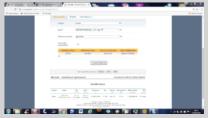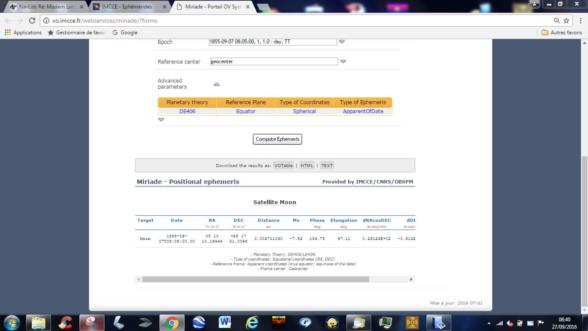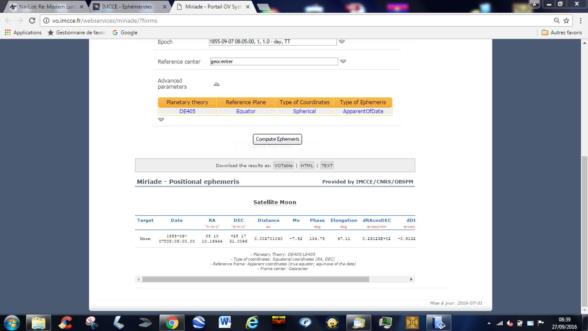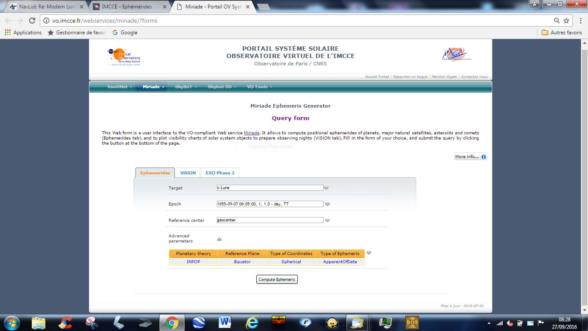
NavList:
A Community Devoted to the Preservation and Practice of Celestial Navigation and Other Methods of Traditional Wayfinding
From: Antoine Couëtte
Date: 2016 Sep 27, 01:29 -0700
Darwin, on Sept 27th, 2016
Dear Paul,
Thanks for your reply, and sorry for having you so much at work !
My essential aim here is to compare our Software results obtained from the same Bodies coordinates (i.e. Lady Moon here) and to check whether - apart from our well known acknowledged and accepted differences in Refraction - there are other differences which could lead us into better refining our Software. The interest of this approach comes from the fact that our Software are significantly different. You are following to the latest UAI recommendations while - for lack of programming space - I am still using the "old way".
I actually doubt that for the pure geometrical computations we will observe any significant differences though, but it is worth taking a look, don't you agree?
But First of all, let me reply to a few queries of yours.
> Does Bureau des Longitudes still use the IAU 1976/80 precession nutation model?
I think that they unfortunately kept using the IAU 1976/80 Precession Nutation Model.
A good way to check this specific point is to compute the Sun Ecliptic Latitudes in the Mean Ecliptic of Date for remote periods, such as for years occuring some 2000 years ago. As nowadays, the Sun Ecliptic latitude should keep oscillating twice a month between values bounded by +/- 1" because the Moon "natural" orbit plan has been and is the Ecliptic of date. In fact, even if apparently "hidden" Precessional Data are always "implicitely contained" in any Planetary Theory computed in a fixed reference (such as 2000.0). As a consequence, computing the Sun Ecliptic of Date coordinates should always be done with a Precession Theory consistent with such Planetary Theory.
I performed this test on the (recently revamped) Bureau des Longitudes Server a few weeks ago with DE406 . I again did not get good results for the Sun for periods having occured 2100 years ago. Hence this is telling me that the Bureau des Longitudes Server is still probably using the now outdated 1976 Precession Theory. To ascertain this point, I computed their Ecliptic Latitude Sun Positions in the 2000.0 reference frame, then "precessioned" them into the Ecliptic of Date through IAU 2006/00A (which I am using also) and ... BINGO ! the Sun Ecliptic Latitudes again behaved "naturally" for those remote periods.
I mentioned this sad fact to Bureau des Longitudes in writing 5 years ago (see enclosed document : " 110303 Quelle est la Précession utilisée par Serveur IMCCE .pdf " ) , but I got no reply at all ... I regret my dear Friend Pierre Bretagnon who had just passed away because - had I mentioned this unwelcome fact to him - things woud have been straightened up by long now.
In such enclosed 2011 document " 110303 Quelle est la Précession utilisée par Serveur IMCCE .pdf " (in French, but you can follow it up easily), in part 1a, you get the Sun Ecliptic Latitudes in the Ecliptic of Date derived by DE406 (red values) + the Precession they were using then in 2011, in part 1b, you get the Sun Ecliptic Latitudes in the Mean Ecliptic 2000.0 and finally in part 1c, you recover "natural" and consistent values for the Mean Ecliptic of Date through manually applying the PO3(1c) Precession which is extremely close from IAU 2006/00A for these dates.
> There are some discrepancies: > 08 10 10.16146 +25 17 31.0209 Bureau des Longitudes > 08 10 10.1690 +25 17 31.006 JPL HORIZONS > 08 10 10.196 +25 17 30.96 me DE406 > 08 10 10.195 +25 17 30.97 me DE422
Just for your information I have also giving you in other enclosed documents some screen shots of the Moon Coordinates for our 1855 Lunar just obtained from the Bureau des Longitudes Server: ( https://www.imcce.fr/langues/fr/ephemerides/, then click onto " Formulaires en ligne " to end up here : https://vo.imcce.fr/webservices/miriade/?forms ).
INPOP2013C, DE405 and DE406 all yield extremely close results, "precise but not accurate" should I probably say since they have probably been "precessionned / nutationed " through our now totally obsolete 1976/1980 Precession/Nutation theories.
Hope it can help ...
Now back to our software comparison :-)
I am suggesting the following steps: please indicate to me the actual Moon Apparent Equatorial Coordinates which you are computing and using for our now [World] famous Lunars #2, #3 and #4, i.e. for Sep 07th 1855 at 08:05:00.000 TT. Also please indicate exactly which deltaT value you are using.
From that I will :
(1) Exactly copy your own Ephemeris results into my Software, and:
(2) Enter the Approximate +0.5"/-0.25" correction on the Ecliptic Coordinates. Actually I will correct your coordinates with their exact equivalent in equator of Date (Δα = +0.478” and Δδ = -0.351” ... BTW these latter numbers you may also independently check, if you so desire), and:
(3) I will afterwards 3D compute the unrefracted Moon UL/Center/LL heights and Azimuths from the WGS84 Observers's 3D positions given in Lunars #2, #3 and #4. Finally:
(4) We will then be able to reliably compare data fully comparable.
Thank you very much for your Kind and Faithful Cooperation.
Best Regards,
Antoine














